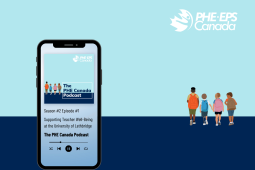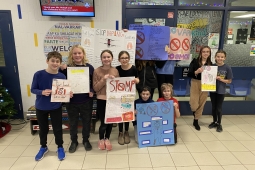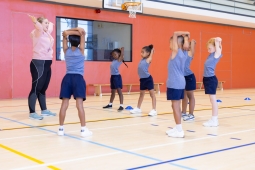How to Get Started with the Sport Education Model

Why Choose the Sport Education Model?
The Sport Education Model (SEM) was developed by Daryl Siedentop in the 1980s and gained wider recognition in physical education with the publication of Sport Education: Quality PE Through Positive Sport Experiences in 1994. Siedentop's critique of traditional physical education highlighted that it often failed to provide students with authentic and meaningful sport experiences. Specifically, he observed that sport instruction in PE lacked several key features commonly found in both school and club sports. Here is how:
- Short Units: Physical education units are typically much shorter than a full sport season, meaning students do not have enough time to develop a deep understanding of the game or hone their skills.
- Isolated Skills: Traditional PE often focuses on practicing isolated techniques through drills, without the context of regular gameplay.
- Lack of Culmination: Unlike club sports, which often culminate in tournaments or competitions, PE lacks a sense of achievement or climax.
As a result, traditional PE often does not provide students with a meaningful understanding of sport or help them appreciate its cultural significance. Siedentop argued that the common “drill to skill” approach in physical education failed to foster lasting interest in sports or promote the transfer of learning to real-world sports participation “beyond the school gate” (Siedentop, 2002; Drummond & Pill, 2011).
What We Know About the Sport Education Model
Research on the implementation of SEM in schools has been extensive, with consistent findings showing that students prefer the SEM over the traditional “drill to skill” approach. The SEM is viewed as more inclusive, motivating, engaging, and autonomy-supportive. Even students who were previously disinterested in or unmotivated by physical education often report a positive experience when using SEM.
The SEM also appears to contribute more effectively to the development of personal and social skills compared to the traditional approach, while offering similar benefits in terms of motor (movement skills) and cognitive (tactical game understanding) domains (Bessa et al., 2021; Evangelio et al., 2018; Manninen & Campbell, 2022).
Key Features of the Model
Let us take a closer look at what a typical SEM lesson might look like in action:
Imagine students stepping out onto the playing field after their previous lesson. Five students, designated as the student-coaches for their teams, meet with the physical education teacher to collect a task card. This card outlines the focus for the warm-up: skill development in preparation for the game, which the student-coaches will lead during the first part of the lesson (an example of Style C: Reciprocal Teaching Style: SueSee et al., 2020).
Meanwhile, another five students, one from each team, are designated as the student-team managers. These managers collect the equipment tubs for their teams, ensuring that everything needed for the skill development session is ready. Each team has a designated area on the field where they begin the preparation-to-play segment of the class.
The team wellbeing manager monitors how everyone is feeling and ensures that team members support each other during the skill development phase. At the end of the class, the wellbeing manager will provide feedback on team cohesion and report it to the teacher using a checklist (an example of Style D: Self-check Teaching Style: SueSee et al., 2020).
As the lesson progresses, the student-team manager monitors the time, signaling when it is time to wrap up the practice and transition into the first competition round of the lesson. Teams that are ready on time earn premiership points, reinforcing punctuality and preparation (an example of Style B: Practice Teaching Style: SueSee et al., 2020).
By Week 3 of a 10-week unit, Team 3 is responsible for umpiring and administering the first competition round. Team 3’s umpires quickly coordinate to decide which playing areas they will oversee. At the start of the competition, the student-team manager blows the whistle to signal the start of play and tracks the time until the game ends. At the end of each competition round, the playing teams thank each other and report their scores to the Team 3 manager, who updates the premiership points ladder.
Throughout the lesson, the student-umpires also evaluate fair play, noting any reasons for point deductions (e.g., arguing with an opponent), which are then added to the overall competition score.

Key Features of SEM
This SEM lesson structure includes several core features:
- Development of Game Competence: Students actively participate in game-based learning, helping them develop their understanding and skills.
- Authentic Sport Experience: The model incorporates essential elements of real-world sport, such as team affiliation, practice-game development, formal competition, and role responsibilities.
- Literacy in Sport: These features encourage students to participate in sports and additionally also to understand the rules, strategies, and social dynamics that make up the sport experience.
In short, the SEM scaffolds students’ development of game competency while teaching them what it means to be a "good sport" and fostering a deeper appreciation for the structure of sport.
Applications of the Sport Education Model
The SEM has been adapted for a wide range of sports and activities. One interesting variant is the clinic-game day model (Alexander & Penney, 2005), which alternates between game development lessons (clinics) and competition-based lessons (game days). The SEM has been successfully evaluated as educatively purposefully with a variety of team and non-team sports, including:
- Team Sports: E.g., Football, basketball, and rugby (many examples)
- Individual Sports: Track and field athletics (Hastie et al., 2013; O'Neil & Krause, 2016), swimming (Scrivener & Penney, 2004), gymnastics (Quill & Clarke, 2004)
- Other Activities: Fitness education (Sluder et al., 2009), wall climbing (Konukman et al., 2011), bike education (Sinelnikov et al., 2005), dance (Graves et al., 2000; Richardson & Oslin, 2003), and outdoor adventure activities (Penney & Wilkie, 2004)
The Take-Home Message
The SEM is a proven and effective curriculum model for quality physical education teaching of recreation pursuits, games and sport for effective learning. Four elements are emphasized that create the conditions for rigorous learning, the development of students as independent and self-regulated learners, and personal connection to the learning (Pill & Williams, 2017):
- Game Modification: Tailoring games to match students’ skill levels, providing an appropriate challenge, and ensuring maximum participation.
- Game Development: Offering opportunities for physical and tactical skill development.
- Team Affiliation: Fostering social-emotional learning through teamwork and role responsibilities.
- Role Responsibility: Encouraging accountability and leadership through various team roles.
Ultimately, the SEM aims to ensure that students become more willing, informed, and positively engaged participants in sport - carrying what they have learned in PE “beyond the school gate” and into their everyday lives (Drummond & Pill, 2011; Siedentop, Hastie & Van der Mars, 2019).
References
Alexander, K., & Penney, D. (2005). Teaching under the influence: feeding games for understanding into the sport education development-refinement cycle. Physical Education and Sport Pedagogy, 10(3), 287-301.
Bessa, C., Hastie, P., Ramos, A., & Mesquita, I. (2021). What actually differs between traditional teaching and sport education in students’ learning outcomes? A critical systematic review. Journal of Sports Science & Medicine, 20(1), 110.
Drummond, M. & Pill, S., (2011). The role of physical education in promoting sport participation in school and beyond. In Georgakis, S., & Russell, K. (Eds.), Youth Sport in Australia: History and Culture (pp.165-178). Sydney University Press.
Evangelio, C., Sierra-Díaz, J., González-Víllora, S., & Fernández-Río, J. (2018). The sport education model in elementary and secondary education: A systematic review. Movimento, 24(3), 931-946.
Graves, M. A., Craves, M. A., & Townsend, J. S. (2000). Applying the sport education curriculum model to dance. Journal of Physical Education, Recreation & Dance, 71(8), 50-54.
Hastie, P. A., Calderón, A., Rolim, R. J., & Guarino, A. J. (2013). The development of skill and knowledge during a sport education season of track and field athletics. Research Quarterly for Exercise and Sport, 84(3), 336-344.
Konukman, F., Perlman, D. J., & Woods, M. L. (2011). Using sport education to teach wall climbing. Journal of Physical Education, Recreation & Dance, 82(7), 10-12.
Manninen, M., & Campbell, S. (2022). The effect of the Sport Education Model on basic needs, intrinsic motivation and prosocial attitudes: A systematic review and multilevel meta-analysis. European Physical Education Review, 28(1), 78-99.
O'Neil, K., & Krause, J. M. (2016). The sport education model: A track and field unit application. Journal of Physical Education, Recreation & Dance, 87(9), 14-20.
Quill, M., & Clarke, G. (2004). Sport Education in gymnastics. In Penney, D., Clarke, G., Quill, M., & Kinchin, G. (Eds.), Sport Education in Physical Education (165-175). Routledge.
Penney, D. & Wilkie, B. (2004). Sport education and outdoor and adventurous activities. In Penney, D., Clarke, G., Quill, M., & Kinchin, G. (Eds.), Sport Education in Physical Education (pp. 216-224). Routledge.
Pill, S., & Williams, J. (2017). Pursuing physical education outcomes through Sport Education. Active and Healthy Journal, 24(2/3), 11-14.
Richardson, M., & Oslin, J. L. (2003). Creating an authentic dance class using sport education. Journal of Physical Education, Recreation & Dance, 74(7), 49-55.
Scrivener, E., & Penney, D. (2004). Sport Education in key stage 4 swimming. In Penney, D., Clarke, G., Quill, M., & Kinchin, G. (Eds.), Sport Education in Physical Education, (pp. 187-205). Routledge.
Siedentop, D. (1994). Sport education: Quality PE through positive sport experiences. Human Kinetics.
Siedentop, D. (2002). Sport Education: A retrospective. Journal of Teaching in Physical Education, 21, 409-418.
Siedentop, D., Doutis, P., Tsangaridou, N., Ward, P., & Rauschenbach, J. (1994). Don’t sweat gym! An analysis of curriculum and instruction. Journal of Teaching in Physical Education, 13, 375-394.
Siedentop, D., Hastie, P., & Van der Mars, H. (2019). Complete guide to sport education, 3rd Edn. Human Kinetics.
Sinelnikov, O. A., Hastie, P. A., Cole, A., & Schneulle, D. (2005). Bicycle safety: Sport education style. Journal of Physical Education, Recreation & Dance, 76(2), 24-29.
Sluder, B. J., Buchanan, A. M., & Sinelnikov, O. A. (2009). Using sport education to teach an autonomy-supportive fitness curriculum. Journal of Physical Education, Recreation & Dance, 80(5), 20-28.
SueSee, B., Hewitt, M. & Pill, S. Eds. (2020) The spectrum of teaching styles in physical education. Routledge.








